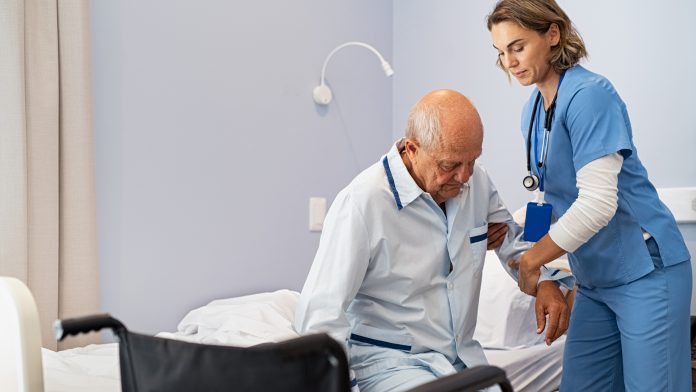
Board members of the National Pressure Injury Advisory Panel outline the key issues in the prevention and treatment of pressure injuries and share some examples of best practices.
Pressure injuries are a significant issue for health systems across the world and can affect patients of all ages. As a result of the COVID-19 pandemic, there has been an increase in the number of pressure injuries seen in the continuum of care. Health Europa Quarterly spoke to National Pressure Injury Advisory Panel (NPIAP) board members about the key challenges impacting the prevention and management of pressure injuries, and some of the solutions helping to improve the effectiveness of wound care.
What are the main causes of pressure injuries and are there certain societal groups who are more susceptible?
Pressure injuries are defined as localised areas of tissue necrosis caused by pressure, or pressure in combination with shear.1 Other factors that impact the skin include nutrition, poor mobility, underlying comorbid conditions and age.2,3 In addition, soft tissue tolerance is also affected by microclimate, perfusion, and the condition of the tissue. There are segments of the population that are more susceptible to pressure injuries including older adults, spinal cord injury patients, individuals with neurodegenerative disorders and the pediatric population. Certain clinical care areas also have a high rate of pressure injuries; these include critical care units, surgical theatres, and long-term care facilities.4
Many older adults face an increased risk due to poor mobility, multiple underlying comorbidities, and changes in the skin including a decrease in subcutaneous fat, flattening of the rete ridges and a decrease in dermal/epidermal turnover. In addition, older adults may have malnutrition, incontinence issues as well as dementia which further heightens their risk.3,5,6,7 The spinal cord injury population has the highest risk of pressure injury development due to lack of mobility and neurological changes below the level of injury.4 This includes congenital spinal cord injury patients. The risk for individuals with neurodegenerative disorders would include poor mobility, possible neurosensory changes, and dysphagia. Medical devices are the main cause of pressure injuries in the pediatric population.8 Other causes include decreased sensation and lack of mobility.
What are some of the key challenges regarding prevention, treatment, and management?
Some of the key challenges to pressure injury prevention include facility resources and lack of education. Depending on the facility, there may be staffing shortages, a lack of necessary supplies, or a lack of appropriate durable medical equipment such as support surfaces, heel offloading devices and positioning devices. Education continues to be a deficit among clinicians which may translate to a lack of proper education for patients, families, and caregivers. Pressure injury prevention is not consistently included in healthcare education and even when provided may not be comprehensive. Ongoing clinical education in the prevention and treatment of pressure injuries is not a mandatory requirement in all health profession curricula.
The treatment of pressure injuries is going to depend on the level of education of the healthcare providers and clinicians involved in the care of the patient.9 In some healthcare settings, the individual mandated to care for wounds may not have any special training or interest in the care of pressure injuries or chronic wounds. There may be limited knowledge of treatment modalities. Additionally, there is a lack of value for the importance of prevention, treatment, and management of pressure injuries. Although the skin is the largest organ system, it is often overlooked as a major cause of morbidity and mortality due to pressure injuries.
Has the COVID-19 pandemic had a significant impact on the treatment and care of patients with pressure injuries?
The primary consequence of infection with COVID-19 is respiratory compromise, ranging from mild upper airway symptoms to severe Adult Respiratory Distress Syndrome (ARDS).10 ARDS often requires mechanical ventilation and prone positioning for many hours to improve oxygenation but is associated with a heightened risk of pressure injuries on dependent body surfaces that protrude (e.g. nose, ears, chin, breasts, penis, knees).
Infection with COVID-19 is also characterised by a hypercoagulable state, as evidenced by the clinical finding of elevated blood levels of D-dimer.11 Autopsy studies have revealed fibrin thrombi in small vessels and capillaries as well as extensive extracellular fibrin deposition. Affected patients often have retiform purpura on their skin reflecting underlying thrombogenic vasculopathy, likely rendering those tissues less tolerant of the damaging effects of pressure and shear and accounting for more severe pressure injuries in patients with COVID-19 than those without COVID-19.11
Interventions to prevent pressure injuries include identifying/monitoring risk factors including BMI > 40kg/m2, Braden score ≤ 12, duration of proning session > 32 hours, and, for sacrococcygeal pressure injuries, D-dimer > 3200 ug/mL.12 Other preventative interventions include positioning on a powered pressure redistribution support surface, taping the oral endotracheal tube (ETT) versus the use of a commercial ETT holder, use of foam head positioner and/or non-powered fluidized positioner, and use of tripolymer pressure redistribution pads or silicone coated foam dressings on bony prominences.

Can you give any examples of best practice techniques for preventing pressure injuries?
Recommendations of care have been put forth that have varying evidence behind them but have proven over the years to yield best practices in the prevention of pressure injuries.2 These best practices include all age groups and high-risk populations. Examples of best prevention practices are:
- Repositioning techniques for individuals who are bedbound or have limited mobility;13
- Addressing nutrition promptly;14
- Assessing risk factors that may create an
opportunity for pressure injury occurrence;15 and - Proper skin and tissue assessment, especially for early detection of pressure injuries.16
These best practices should be incorporated in all care settings, including at home, to help avoid pressure injury formation as feasible. While recommended prevention strategies address various situations and populations, healthcare workers should be mindful that strategies should also be tailored to an individual’s specific needs as they arise.
Are there any notable developments or current issues in the world of wound care which you would like to highlight?
In recent years, there has been new technology launched in the field of pressure injury prevention which will hopefully impact the incidence of pressure injuries in all care settings. This includes newer support surfaces with a focus on microclimate, real-time pressure mapping systems and devices that can detect changes in skin temperature to moisture levels and alert providers of tissue damage before visual changes on the surface of the skin occur. This new technology can also help in the detection of pressure injuries in individuals with darker pigmentation in their skin in which earlier signs of pressure damage may be missed. Implementation of these technologies will require further education for healthcare systems to see their value.
Authors
Aimee D. Garcia, MD, CWS, FACCWS, Barbara Delmore PhD, RN, CWCN, MAPWCA, IIWCC-NYU, FAAN, Virginia Capasso, PhD, ANP-BC, ACNS-BC, CWS, FACCWS, FAAN, and Ann Marie Nie, PhDc, APRN, CNP, FNP-BC, CWOCN
References:
- Edsberg LE, Black JM, Goldberg M, McNichol L, Moore L, Sieggreen M. ‘Revised National Pressure Ulcer Advisory Panel Pressure Injury Staging System’. Journal of Wound, Ostomy and Continence Nursing. 2016;43(6):585-597. doi:10.1097/WON.0000000000000281
- European Pressure Ulcer Advisory Panel, National Pressure Injury Advisory Panel, Pan Pacific Pressure Injury Alliance. Prevention and Treatment of Pressure Ulcers/Injuries: Clinical Practice Guideline. The International Guideline. (Haesler E, ed.). European Pressure Ulcer Advisory Panel, National Pressure Injury Advisory Panel and Pan Pacific Pressure Injury Alliance; 2019
- European Pressure Ulcer Advisory Panel, National Pressure Injury Advisory Panel, Pan Pacific Pressure Injury Alliance. Nutrition in pressure injury prevention and treatment. In: Haesler E, ed. Prevention and Treatment of Pressure Ulcers/Injuries: Clinical Practice Guideline: The International Guideline 2019. European Pressure Ulcer Advisory Panel, National Pressure Injury Advisory Panel and Pan Pacific Pressure Injury Alliance; 2019:94-114
- European Pressure Ulcer Advisory Panel, National Pressure Injury Advisory Panel, Pan Pacific Pressure Injury Alliance. Populations with Specific Pressure Injury Related Needs. In: Haesler E, ed. Prevention and Treatment of Pressure Ulcers/Injuries: Clinical Practice Guideline. The International Guideline 2019. European Pressure Ulcer Advisory Panel, National Pressure Injury Advisory Panel and Pan Pacific Pressure Injury Alliance; 2019:28-37
- European Pressure Ulcer Advisory Panel, National Pressure Injury Advisory Panel, Pan Pacific Pressure Injury Alliance. Preventive Skin Care. In: Haesler E, ed. Prevention and Treatment of Pressure Ulcers/Injuries: Clinical Practice Guideline: The International Guideline 2019e Guideline. European Pressure Ulcer Advisory Panel, National Pressure Injury Advisory Panel and Pan Pacific Pressure Injury Alliance; 2019:84-93
- European Pressure Ulcer Advisory Panel, National Pressure Injury Advisory Panel, Pan Pacific Pressure Injury Alliance. Heel Pressure Injuries. In: Haesler E, ed. Prevention and Treatment of Pressure Ulcers/Pressure Injuries: Clinical Practice Guideline: The International Guideline 2019 European Pressure Ulcer Advisory Panel, National Pressure Injury Advisory Panel and Pan Pacific Pressure Injury Alliance; 2019:145-154
- European Pressure Ulcer Advisory Panel, National Pressure Injury Advisory Panel, Pan Pacific Pressure Injury Alliance. Etiology. In: Haesler E, ed. Prevention and Treatment of Pressure Ulcers/Injuries: Clinical Practice Guideline. The International Guideline. European Pressure Ulcer Advisory Panel, National Pressure Injury Advisory Panel and Pan Pacific Pressure Injury Alliance; 2019:16-27
- Delmore B, Deppisch M, Sylvia C, Luna-Anderson C, Nie AM. ‘Pressure Injuries in the Pediatric Population: A National Pressure Ulcer Advisory Panel White Paper’. Adv Skin Wound Care. 2019;32(9). doi:10.1097/01.ASW.0000577124.58253.66
- European Pressure Ulcer Advisory Panel, National Pressure Injury Panel, Pan Pacific Pressure Injury Alliance. Health Professional Education. In: Haesler E, ed. Prevention and Treatment of Pressure Ulcers/Injuries: Clinical Practice Guideline: The International Guideline 2019e Guideline. European Pressure Ulcer Advisory Panel, National Pressure Injury Advisory Panel and Pan Pacific Pressure Injury Alliance; 2019
- Ackermann M, Verleden SE, Kuehnel M, et al. ‘Pulmonary Vascular Endothelialitis, Thrombosis, and Angiogenesis in Covid-19’. N Engl J Med. 2020;383(2):120-128. doi:10.1056/nejmoa2015432
- Magro C, Mulvey JJ, Berlin D, et al. ‘Complement associated microvascular injury and thrombosis in the pathogenesis of severe COVID-19 infection: A report of five cases’. Transl Res. 2020;220:1-13. doi:10.1016/j.trsl.2020.04.007
- Capasso V, Snydeman C, Miguel K, et al. ‘Pressure Injury Development, Mitigation, and Outcomes of Patients Proned for Acute Respiratory Distress Syndrome’. Adv Skin Wound Care. 2022;35(4):202-212. doi:10.1097/01.ASW.0000767404.02594.85
- European Pressure Ulcer Advisory Panel, National Pressure Injury Advisory Panel, Pan Pacific Pressure Injury Alliance. Repositioning and Mobilization. In: Haesler E, ed. Prevention and Treatment of Pressure Ulcers/Injuries: Clinical Practice Guideline: The International Guideline 2019. European Pressure Ulcer Advisory Panel, National Pressure Injury Advisory Panel and Pan Pacific Pressure Injury Alliance; 2019:115-144
- Munoz N, Litchford M, Cox J, Nelson JL, Nie AM, Delmore B. ‘National Pressure Injury Advisory Panel White Paper malnutrition and pressure injury risk in vulnerable populations: Application of 2019 International Clinical Practice Guideline’. Adv Skin Wound Care. 2022;35(March):156-165. doi:10.1097/01.ASW.0000816332.60024.05
- European Pressure Ulcer Advisory Panel, National Pressure Injury Advisory Panel, Pan Pacific Pressure Injury Alliance. Risk Factors and Risk Assessment. In: Haesler E, ed. Prevention and Treatment of Pressure Ulcers/Pressure Injuries: Clinical Practice Guideline: The International Guideline 2019. European Pressure Ulcer Advisory Panel, National Pressure Injury Advisory Panel and Pan Pacific Pressure Injury Alliance, National Pressure Injury Advisory Panel and Pan Pacific Pressure Injury Alliance; 2019:38-72
- European Pressure Ulcer Advisory Panel, National Pressure Injury Advisory Panel, Pan Pacific Pressure Injury Alliance. Skin and Tissue Assessment. In: Haesler E, ed. Prevention and Treatment of Pressure Ulcers/Pressure Injuries: Clinical Practice Guideline: The International Guideline 2019. European Pressure Ulcer Advisory Panel, National Pressure Injury Advisory Panel and Pan Pacific Pressure Injury Alliance; 2019:73-83
National Pressure Injury Advisory Panel
https://npiap.com/
https://www.linkedin.com/company/national-pressure-ulcer-advisory-panel-inc/about/
https://www.facebook.com/pages/National-Pressure-Ulcer-Advisory-Panel/136005669757248
https://www.youtube.com/channel/UC6Ytd__UZVw52lagr1XvmDg






















